Villingen-Schwenningen
| Villingen-Schwenningen | ||
|---|---|---|
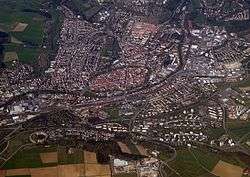 View of Villingen | ||
| ||
 Villingen-Schwenningen Location of Villingen-Schwenningen within Schwarzwald-Baar-Kreis district 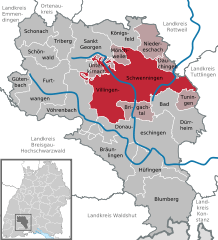  | ||
| Coordinates: 48°03′37″N 08°27′31″E / 48.06028°N 8.45861°ECoordinates: 48°03′37″N 08°27′31″E / 48.06028°N 8.45861°E | ||
| Country | Germany | |
| State | Baden-Württemberg | |
| Admin. region | Freiburg | |
| District | Schwarzwald-Baar-Kreis | |
| Government | ||
| • Mayor | Dr. Rupert Kubon (SPD) | |
| Area | ||
| • Total | 165.47 km2 (63.89 sq mi) | |
| Elevation | 704 m (2,310 ft) | |
| Population (2017-12-31)[1] | ||
| • Total | 84,557 | |
| • Density | 510/km2 (1,300/sq mi) | |
| Time zone | CET/CEST (UTC+1/+2) | |
| Postal codes | 78001–78056 | |
| Dialling codes | 07721, 07720, 07425, 07705 | |
| Vehicle registration | VS | |
| Website | www.villingen-schwenningen.de | |
Villingen-Schwenningen (German pronunciation: [ˈfɪlɪŋən ˈʃvɛnɪŋən]) is a town in the Schwarzwald-Baar district in southern Baden-Württemberg, Germany. It has 84,818 inhabitants (as of January 2018).[2]
History
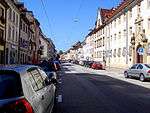
In the Middle Ages Villingen was a town under Austrian lordship. During the Protestant Reformation it remained Catholic. Villingen came to international attention when it was besieged by marshal Tallard in 1704. Colonel Von Wilstorff put up a stout defence of the outdated fortifications, and after six days the siege failed.
Schwenningen remained a village until the 19th century. In 1858 the first watch factory was established, and watchmaking and precision mechanics have been important industries ever since. The town styled itself "the greatest watch city in the world"[3] at one time, and the Kienzle Uhren watchmaking company was founded there in 1822 and remained until moving to Hamburg in 2002. The Museum of Clockmaking celebrates the town's clock and watchmaking history.
As part of the Baden-Württemberg territorial reform of 1972, Villingen and Schwenningen were merged with a number of surrounding villages to form the city of Villingen-Schwenningen. Nevertheless, the two halves of the city are separated by a plateau and remain distinct. Villingen is a former part of Baden, while Schwenningen is a former part of Württemberg.
Villingen is a major center of German Carneval celebrations. The traditional Narros represent the old citizens of Villingen: Alt Villingere, Morbili, Narro, Suribbel.
Since 1904, Villingen-Schwenningen has also been home to the ice hockey team the Schwenninger Wild Wings which competes in the Deutsche Eishockey Liga.
Geography
Villingen-Schwenningen lies on the eastern edge of the Black Forest about 700 m (2,300 ft) above sea level. The source of the River Neckar is in Schwenningen (Schwenninger Moos).
Boroughs
- Villingen
- Schwenningen
- Obereschach
- Weilersbach
- Weigheim
- Mühlhausen
- Marbach
- Rietheim
- Pfaffenweiler
- Herzogenweiler
- Tannheim
Mayors and Lord mayors of Villingen
- 1912–1930: Guido Lehmann
- 1931–1933: Adolf Gremmelspacher
- 1933: Gutmann, temporary
- 1933–1937: Hermann Schneider
- 1937–1940: Karl Berckmüller
- 1940–1945: Hermann Riedel
- 1945–1946: Walter Bräunlich
- 1946: Edwin Hartmann
- 1946–1950: Edwin Nägele
- 1950–1972: Severin Kern
Mayors and Lord mayors of Schwenningen
- 1797–1816: Erhard Bürk
- 1816–1819: (Vogt)
- 1819–1821: Thomas Wegler
- 1821–1825: ?
- 1825–1835: Matthias Rapp
- 1835–1841: Johann Georg Koch
- 1841–1852: Andreas Bürk
- 1852–1857: Christian Strohm
- 1857–1887: Erhard Müller
- 1887–1912: David Würth
- 1912–1925: Emil Braunagel
- 1925–1930: Ingo Lang von Langen
- 1930–1948: Otto Gönnenwein
- 1949–1962: Hans Kohler
- 1962–1972: Gerhard Gebauer
Lord mayors of Villingen-Schwenningen
- 1972–1994: Gerhard Gebauer (SPD)
- 1994–2002: Manfred Matusza (CDU)
- since 2002: Rupert Kubon (SPD)
Number of inhabitants (Villingen-Schwenningen)
|
Source: Statistical office Baden-Württemberg
The 10 largest communities of foreigners are :
Main sights
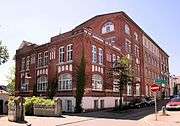
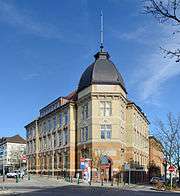
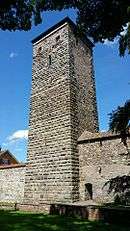
- Town Wall
- Municipal Art Gallery
- Franciscan Monastery Museum (in German)
- Schwenningen Clock Museum (in German)
- Minster of Our Lady
- Theater am Ring
- Wanne Observation Tower, one of the oldest towers built of iron
- Internationales Luftfahrt-Museum, aviation museum
International relations/sister cities






Notable people
- Georg Pictorius (around 1500–1569), physician and mystic-magical author of the Renaissance
- Trudpert Neugart (1742–1825), professor for oriental languages
- Johannes Benzing (1913–2001), Turkologist and diplomat
- Martin Barner (born 1921), mathematician
- Kurt Leichtweiss (1927–2013), mathematician
- Hartmann von der Tann (born 1943), journalist
- Rainer Baumann (1949–2007), guitarist, composer and lyricist
- Horst Ludwig Meyer (1956–1999), presumed member of the Red Army Faction (RAF)
- Veit Heinichen (born 1957), writer
- Gundolf Köhler (1959-1980), right-wing extremist
- Andreas K. Engel (born 1961), brain researcher
- Robert Prosinečki (born 1969), Croatian footballer and coach
- Michelle (born 1972), singer
- Thorsten Schmitt (born 1975), Nordic Combiner
- Oliver Roggisch (born 1978), handball player
- Martin Schmitt (born 1978), ski jumper
- Andreas Lang (born 1979), curler
- Dennis Seidenberg (born 1981), ice hockey player (New York Islanders)
- Ivana Brkljačić (born 1983), Croatian hammer thrower
- Jochen Schöps (born 1983), volleyball player
- Marco Caligiuri (born 1984), German-Italian footballer
- Adem Sarı (born 1985), Turkish footballer
- Daniel Caligiuri (born 1988), German-Italian footballer
- Florian Rudy (born 1989), footballer
- Sebastian Rudy (born 1990), footballer
- Domenic Weinstein (born 1994), cyclist
References
- ↑ "Bevölkerung nach Nationalität und Geschlecht am 31. Dezember 2017". Statistisches Landesamt Baden-Württemberg (in German). 2018.
- ↑ Villingen-Schwenningen, Stadt. "Zahlen, Daten, Fakten - Villingen-Schwenningen". www.villingen-schwenningen.de (in German). Retrieved 2018-03-06.
- ↑ "Villingen-Schwenningen - Watch Wiki: The Best Watches and Watch Brands". www.watch-wiki.net. Retrieved 14 April 2018.
- ↑ Villingen-Schwenningen, Stadt. "Partnerschaften - Villingen-Schwenningen". www.villingen-schwenningen.de. Retrieved 14 April 2018.
External links
| Wikimedia Commons has media related to Villingen-Schwenningen. |
| Wikivoyage has a travel guide for Villingen-Schwenningen. |
- Official website

- Villingen-Schwenningen: history & pictures (in German)
- The siege of Villingen in 1702
